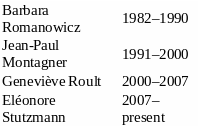IMPERVIOUS SURFACE DATA COLLECTION WORKSHOP CALIFORNIA REGIONAL WATER QUALITY
IMPERVIOUS SURFACE DATA COLLECTION WORKSHOP CALIFORNIA REGIONAL WATER QUALITYIMPERVIOUS SURFACES REVIEW OF RECENT LITERATURE CHRISTINE TILBURG AND
PROJECT DESCRIPTION DEVELOPMENT OR REDEVELOPMENT DRAINAGE AREA IMPERVIOUS PERVIOUS
Management Questions Relative to Impervious Surfaces Tracking Request
Impervious Surface Data Collection Workshop
California Regional Water Quality Control Board
San Francisco Bay
9:00 to 12:00
Tuesday, October 11, 2005
Room 11, 2nd Floor of Elihu M. Harris Building
1515 Clay Street, Oakland
Introductions
Opening Remarks (Dr. Lawrence Kolb, Assistant Executive Officer, Water Board)
Background of this workshop and other future workshops by Water Board (Shin-Roei Lee, South Bay Watershed Division, Water Board)
Review management questions (see attached) and framework for addressing these questions (Sandia Potter, Workshop Facilitator, Water Board)
Impervious Surface Data Collection
Review of existing data from Santa Clara County (Sue Ma, Water Resource Control Engineer, Water Board)
Other on-going efforts (Dr. Jack Gregg – impervious surface tracking for Non-Point Source program at California Coastal Commission, Dr. Lester McKee – storm drain systems mapping by SFEI, others?)
Identify any other existing sources of data (workshop participants) – If possible, please share with the group a copy of the form used, the type of info. collected, the length of time of the data set, the estimated costs associated with the data collection, how data are used, etc.
Completeness of the existing data and options of collecting additional data
Summarize lessons learned and agree on next steps
Conclusions (Shin-Roei Lee)
Management Questions Relative to Impervious Surface Data Collection
Why collect the data?
How will the data be used?
Why collect the data now?
What is the link to water quality?
What existing data are available?
What would the costs/benefits be for collecting additional data?
How could the data be translated into credit toward waste load allocation?
How could the data be used to measure stormwater program (or other programs) effectiveness?
How to use the data to prioritize stormwater management activities?
Where would reduction in imperviousness (and decreases in drainage density) have large cumulative benefits in terms of groundwater recharge and storage?
How could the data be used to create incentives to reduce imperviousness in watersheds?
What information is there to suggest if there is any link between imperviousness and water quality?
What is the relative magnitude of projected impervious surface increase due to small parcels (less than 10,000 square feet of impervious surface) compared to parcels having greater than 10,000 square feet of new/replaced impervious surface in the county as a whole and in each community?
If the percentage increase due to small parcels is significant (say 30-50%) of the total, is it feasible (economically, public acceptance) to require pollutant and flow controls on smaller parcels? What incentives are there to control pollutant and flow impacts?
If it is not feasible to address stormwater discharges from impervious surface increases from small parcels, what can be done to mitigate for the projected increase in pollutant loads and erosive forces? How would that be paid for?
Is it necessary to collect the data for all projects and from everywhere in the region?
At what stage in the local approval process should the data be collected?
How could existing data be used to make a credible estimate of the relative magnitude of projected impervious surface increase due to small parcels (less than 10,000 square feet of impervious surface) compared to parcels having greater than 10,000 square feet of new/replaced impervious surface in the region as a whole?
How would the data be used in the future Municipal Regional Permit?
Under what conditions do impervious surface increases contribute to pollutant loads or erosive forces in creeks? Under what conditions do impervious surface increases not contribute to pollutant loads or erosive forces in creeks?
To what degree are the discharges from existing imperviousness contributing to pollutant loads and/or erosive forces in creeks?
Tags: california regional, at california, collection, regional, quality, surface, water, california, impervious, workshop
- CONTRATO DE ARRENDAMIENTO DE SERVICIOS PROFESIONALES EN LA CIUDAD
- NUMER WNIOSKU W REJESTRZE I DATA ZŁOŻENIA …………………………………………… (WYPEŁNIA
- GOAL TRACKING WORKSHEET THIS IS A WORKSHEETPLANNING DOCUMENT TO
- GNIEŹNIEŃSKA AGENCJA ROZWOJU GOSPODARCZEGO SP Z OO STRATEGIA ROZWOJU
- HIGHLAND LITERACY PROJECT WWWHVLCORGUKHLP TEACHING WRITER’S CRAFT THROUGH READING
- PROPUESTA DE PROVISIÓN DE PLAZAS DE PROFESOR ASOCIADO DE
- GENERALIDADES DEL PROGRAMA GENERALIDADES DE LA SESIÓN ESTA
- 4 DE OUTUBRO DE 2006 PRESS RELEASE ESPELHADA NOS
- İSTANBUL ÜNIVERSITESI SÜREKLI EĞITIM MERKEZI İŞYERI HEKIMLIĞI EĞITIM KURUMU
- PARTNERSHIP FOR CHILD DEVELOPMENT DIAGNOSTICO Y ANALISIS RAPIDO
- VUMC INSTITUTIONAL REVIEW BOARD INFORMED CONSENT DOCUMENT FOR RESEARCH
- SOLICITUD CLASE MAGISTRAL CLASE MAGISTRAL CON DIEGO MONTOYA LUGAR
- BASES DEL TERCER CONCURSO NACIONAL DE PROYECTOS DE INVESTIGACION
- MODELO NORMALIZADO AM SOLICITUD DE ACCESO A MÁSTER UNIVERSITARIO
- PRIMIJENJENE STUDIJE U BARU I BIJELOM POLJU HEMIJA 1
- ANEXO II2 PROPUESTA DE TRABAJO FIN DE CARRERA DE
- BERRIKUNTZAREN GIZARTE KONPROMISOAREN ETA KULTURGINTZAREN ARLOKO ERREKTOREORDETZA VICERRECTORADO DE
- MUSIKSCHULE DER STADT DATTELN KOLPINGSTRASSE 1 45711 DATTELN
- DECRET DE 14 DE FEBRER DE 1947 PEL QUAL
- DOCUMENTOS NECESARIOS PARA LA INSCRIPCIÓN EN EL CENSO
- VÝSLEDKOVÁ LISTINA MUŽI MORAVSKOBUDĚJOVICKÝ TRIATLON TERMÍN KONÁNÍ NEDĚLE
- TINC UNA URGÈNCIA ON MADREÇO? EL SISTEMA SANITARI PÚBLIC
- (IME I PREZIMETVRTKA PODNOSITELJA ZAHTJEVA) (ADRESA)
- 31 JOURNAL OF EXERCISE PHYSIOLOGYONLINE DECEMBER 2017 VOLUME 20
- TOPIC TEST TOPIC 2 2D ARRAYS MULTIPLE CHOICE
- MANUAL DE MANTENIMIENTO PARA ASEGURARSE DE QUE SU DRONE
- CARRERER CATEGORIES 2010 VIA PARITAT DE NÚM FINS NÚM
- 2 SGPROPUESTA 300 14 DE SEPTIEMBRE DE
- 3ROBOT KINEMATICS PURPOSE THE PURPOSE OF THIS CHAPTER
- EL CÓNDOR ANDINO SE ENCUENTRA DISTRIBUIDO A LO LARGO
 SPEAK UP FOR A CHILD ATHENSOCONEE CASA PROGRAM INC
SPEAK UP FOR A CHILD ATHENSOCONEE CASA PROGRAM INCDENOMINACIÓN TRABAJO SOCIAL COMUNITARIO I METODOLOGIA Y APLICACIÓN CARÁCTER
ODVJETNICA JELENA GRBEŠIĆ IZ ZAGREBA VLADE GOTOVCA 1 ZAGREB
 WATER ATMOSPHERIC MEASUREMENT NORMALLY CHECKING LIST WHEN YOU ARE
WATER ATMOSPHERIC MEASUREMENT NORMALLY CHECKING LIST WHEN YOU ARE UNIT 2FPC710 (F97A 04) PREPARE COOK AND FINISH BASIC
UNIT 2FPC710 (F97A 04) PREPARE COOK AND FINISH BASIC16 LINAJE Y LEGITIMIDAD EN LA HISTORIOGRAFÍA REGIA HISPANA
SITE STABILITY SESSION SUMMARY SESSION CHAIR MIKE PEARLMAN MIKE
[ BIKEONET KERESKEDELMI ÉS SZOLGÁLTATÓ KFT ] [ ADÓSZÁM
 37 SECRETARÍA MUNICIPAL GMCGSJJYJT ACTA DE CONCEJO Nº 15
37 SECRETARÍA MUNICIPAL GMCGSJJYJT ACTA DE CONCEJO Nº 15INFORMATIVO 042017 ASSUNTO ABERTURA DE CADASTRAMENTO PARA CANDIDATOS JÁ
KSIĄŻKI MIESIĄCA „MAGAZYNU LITERACKIEGO KSIĄŻKI” W 2012 ROKU
 FRANÇOISE DUQUESNEBELFAIS INSHEA LE TEST ECPN
FRANÇOISE DUQUESNEBELFAIS INSHEA LE TEST ECPN  19 CHECKLIST 3 DAILYWEEKLY CLEANING SCHEDULE (INITIAL WHEN COMPLETED)
19 CHECKLIST 3 DAILYWEEKLY CLEANING SCHEDULE (INITIAL WHEN COMPLETED) DRAGI UČENCI UČENKE IN STARŠI! VAS PESTIJO MOREBITNE UČNE
DRAGI UČENCI UČENKE IN STARŠI! VAS PESTIJO MOREBITNE UČNENZQA UNIT STANDARD 17385 VERSION 7 PAGE 3 OF
 ELECTRONIC SUPPLEMENT FOR THE GEOSCOPE PROGRAM PROGRESS AND CHALLENGES
ELECTRONIC SUPPLEMENT FOR THE GEOSCOPE PROGRAM PROGRESS AND CHALLENGES CONTRATOS PREDOCTORALES MEMORIA DEL PLAN DE TRABAJO A DESARROLLAR
CONTRATOS PREDOCTORALES MEMORIA DEL PLAN DE TRABAJO A DESARROLLAR UPITNIK ZA KOMENTARE UCESNIKA O KURSUAKTIVNOSTI NAZIV KURSAAKTIVNOSTI DATUMI
UPITNIK ZA KOMENTARE UCESNIKA O KURSUAKTIVNOSTI NAZIV KURSAAKTIVNOSTI DATUMIDZIEŃ LP GODZ VII VI V IV III II
TC ERCİYES ÜNİVERSİTESİ REKTÖRLÜĞÜ KAMU HİZMET STANDARTLARI TABLOSU REKTÖRLÜK